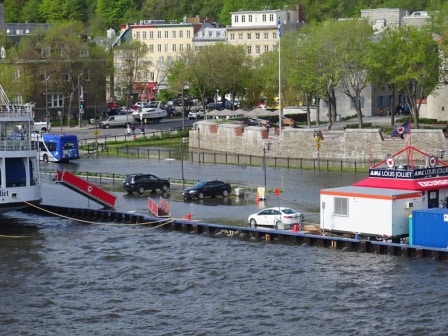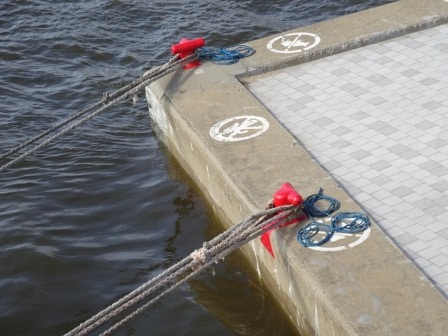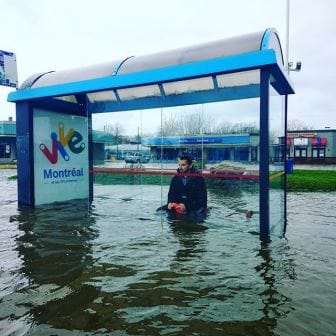We have a little bit of a troublesome situation with the weather here on the river. I already mentioned during the Quebec call two days ago that the water was extremely high. Due to a lot of rain water coming down and a lot of sea water going up. This has only intensified itself and last night the Canadian Authorities announced a Surge – Warning for the coast and up the river. Basically all the way down the St. Lawrence River from the moment the tidal movement had any influence on the water height of the river. Regular flood warnings have been in force for the last week or so, all the way up Montreal and even beyond.

It was a very close call at the Ferry dock, and it was not even high water. Some streets behind did overflow.
A storm surge can occur if certain elements in nature enhance each other and most of the time the end result gives reason for concern. A heavy storm during Spring tide can increase a water level so much that the levees and dykes over flow. At the moment we have large amounts of rain water coming down the river, and we have high sea tides and at the same time we have a strong on-shore wind pushing that high water tide even higher while it goes inland and up the river. Quebec has had a lot of rainwater in the last week or so and even called the army in to help out in the worst areas.
Not much you can do when the river goes higher as far as the ships are concerned. We float and will not get wetter than normal and we just have to hope the water will not go so high that we cannot see the docks and the bollards anymore. Today we did not have that as an issue with that but the captain brought the arrival for Quebec one hour forward just to ensure that we still fitted under the Quebec Bridge in case the water would rise more than expected.

The regular docks are a little bit higher but normally we have much more dock level clearance than this.
As said we did not have an issue, there was still about 2 feet of Quay height were we could dock against. It made the Staff Captain very happy as it made it much easier to do maintenance on the ship’s hull near the water line. Shore side they did have problems, the road near the ferry dock was flooded again and also the lower level of the parking garage had more than a foot of water in it. I did not see any cars on the higher levels and thus I assume that the entrance must have been on the street level. I hope the water was not affecting the electronics; otherwise the garage might be closed for a while, unless they go for free parking while barriers and ticket machines are being repaired.
Today I got a lot of exercise as I was in my inspection mode again. I went in the Engine Room for a walkabout. A ships engine room is an enclosed space or better said a number of enclosed spaces, separated by water tight doors which are closed while the ship is sailing. When there is an emergency is can be difficult to get out. Remember that nearly all the engineers on the Titanic perished as they were stuck somewhere down there.
Since that time, more focus has been given to improving the escape options from those enclosed spaces. It is now since a long time compulsory that each engine room space has at least two exits. A normal one and one which leads directly to a deck about the Bulkhead deck. The bulkhead deck is deck under where the watertight doors divide the ship in sections and enclose the most vulnerable area of the ship in relation to sinking. In most sections of the engine room they are vertical pipes called Emergency Escapes with a door at the lowest deck – entry level and a door above the bulkhead deck – exit level. Auditors such as Lloyds and Coastguard can always get very excited about them and it is a standard part of their inspection to look inside. I normally go one better, I climb them all. All 9 of them, 3 to 4 decks up and all with vertical steel bulkhead ladders. Good exercise as long as you are not claustrophobic or suffer from vertigo.
This evening we sailed just before 17.00 hrs. and used two tugboats to do so. We had almost 30 knots of wind full on the beam and a strong ebb current running…………. And that current could have pushed us along the dock and then press us again at an outcrop further down. If that would happen the wind on the beam would then help the current to keep us there. That is something we do not like of course and thus we employ tugboats as 30 knots of beam wind is too much for the ships thrusters to create a swift lift off and deal with the current at the same time. Once off the berth we continued our descend towards the sea. Thus tomorrow we will in open waters heading for Charlottetown on Prince Edward Island. Early tomorrow morning we will disembark the pilots again at Escomins and then enter the St. Lawrence Estuary. Weather should be nice with partly sunny skies but with chilly temperatures.


Leave a Reply